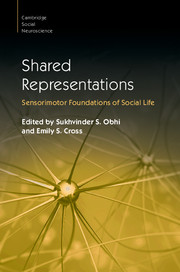Book contents
- Shared Representations
- Cambridge Social Neuroscience
- Shared Representations
- Copyright page
- Contents
- Figures
- Tables
- Boxes
- Contributors
- Preface
- Part I Foundations
- Part II Imitation and Mimicry
- Part III Thinking, Perceiving and Acting with Others
- 10 Levels of Complexity and the Duality of Gaze
- 11 Acting Together
- 12 Joint Perception
- 13 Social Antecedents and Consequences of Behavioral Synchrony
- 14 Musical Ensemble Performance
- Part IV Understanding Others
- Part V Learning and Development
- Part VI Shared Representations in Applied Contexts
- Index
- Plate Section (PDF Only)
- References
14 - Musical Ensemble Performance
Representing Self, Other and Joint Action Outcomes
from Part III - Thinking, Perceiving and Acting with Others
Published online by Cambridge University Press: 27 October 2016
- Shared Representations
- Cambridge Social Neuroscience
- Shared Representations
- Copyright page
- Contents
- Figures
- Tables
- Boxes
- Contributors
- Preface
- Part I Foundations
- Part II Imitation and Mimicry
- Part III Thinking, Perceiving and Acting with Others
- 10 Levels of Complexity and the Duality of Gaze
- 11 Acting Together
- 12 Joint Perception
- 13 Social Antecedents and Consequences of Behavioral Synchrony
- 14 Musical Ensemble Performance
- Part IV Understanding Others
- Part V Learning and Development
- Part VI Shared Representations in Applied Contexts
- Index
- Plate Section (PDF Only)
- References
Summary
Musical ensemble performance constitutes a refined form of joint action that involves the non-verbal communication of information about musical structure and expressive intentions via co-performers’ sounds and body movements. Successful musical communication requires co-performers to coordinate their actions across multiple musical dimensions (pitch and rhythm), timescales (expressive micro-timing versus large-scale tempo changes), sensory modalities (auditory and visual) and modes of interaction (unison versus complementary action). From a psychological perspective, ensemble performance necessitates precise yet flexible interpersonal coordination at the level of sensorimotor, cognitive, emotional and social processes. The current chapter addresses how such interpersonal coordination is facilitated by representations of shared performance goals, which are consolidated during preparation for joint musical performance. During actual performance, these shared goal representations interact with online sensorimotor and cognitive processes that allow co-performers to anticipate, attend and adapt to each other’s actions in real time. Studies employing behavioral and brain methods provide evidence for three functional characteristics of shared musical representations. First, shared representations involve the integration of information related to one’s own part, others’ parts and the joint action outcome, while maintaining a distinction between self and other. Second, self, other and joint action outcomes are represented in predictive internal models. Third, internal models recruit the motor system to simulate self- and other-produced actions at multiple hierarchical levels. Shared musical representations thus facilitate exquisite real-time interpersonal coordination by dynamically embodying intended action outcomes related to the self, others and the ensemble as a whole.
- Type
- Chapter
- Information
- Shared RepresentationsSensorimotor Foundations of Social Life, pp. 280 - 310Publisher: Cambridge University PressPrint publication year: 2016
References
- 42
- Cited by

